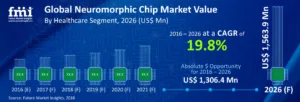Quantum computational abilities of neuromorphic chips have led to their adoption in the vast expanse of global healthcare industry. On account of their exceptional processing capabilities, neuromorphic chips are expected to play a key role in the improvement of drug development for pharmaceutical manufacturers.
Neuromorphic chips will be integrated in multiple fields of bioinformatics and pharmacology, enabling scientists to formulate newer drugs and medicine compounds. With that, the Big Data prowess of neuromorphic chips is expected to further redefine the known limits of data analytics in drug-making processes and pharmacological procedures. The healthcare sector is in the midst of a transformation fuelled by adoption of advanced technology, and large-scale use of neuromorphic chips is expected to further this trend.
Neural Networks Transforming Pharmacology
Deep Artificial Neural Networks (DNNs) serve to be an exigent aspect in the development of Artificial Intelligence (AI). Over the past few years, the global pharmaceuticals industry has witnessed an active integration of multiple AI platforms for enhancement of computational processes that have always been riddled with human errors.
AI interfaces developed on Deep Learning (DL) models have extended the application of DNNs in pharmacology and drug development. Needless to say, demand for neuromorphic chips in the global pharmaceuticals sector will continue to grow exponentially as several drug manufacturers are promoting the incorporation of DNNs to facilitate manufacturing operations in design, discovery, and validation of a drug.
In the next decade, healthcare industrial verticals such as pharmacology are estimated to create an incremental opportunity of over US$ 1 billion dollars in terms of revenues for the global neuromorphic chips market. A recent study on the global market for neuromorphic chips, developed by Future Market Insights, projects that by 2026, pharmaceuticals manufacturers & healthcare companies will act as prominent end-users of neuromorphic chips, accounting for an estimated US$ 1.5 billion in revenues. Furthermore, ongoing research on applicability of DNNs in pharmacology is likely to unlock the potential for using neuromorphic chips in areas such as genomics, metabolomics and proteomics.
Facilitating Proteomic Prediction Measures
Neuromorphic chips can be integrated in pharmaceutical procedures such as protein structure prediction and other areas of bioinformatics. Adopting custom-made ML methods and Artificial Neural Networks (ANNs) for predicting protein secondary structure enables drug manufacturers to analyze multiple protein sequences and derive an evolutionary pathway for intermolecular links & structures.
A recent study conducted by researchers at the University of California has put forth three ways in which the use of neuromorphic chips in DL architecture facilitates the prediction of protein contact map. Additionally, the application of neuromorphic chips in proteomics can also help estimate the sequence specificities of RNA and DNA binding proteins through Deep Convolutional Neural Networks (DCNNs).
Neuromorphic Chips in Bioinformatics
In genomic medicine, neuromorphic chips are rendered useful due to their analytical abilities through Big Data models. Extracting complex data in the fields of genomics, metabolomics, and transcriptomics becomes impossible through conventional data processing networks. Neuromorphic chips in DNNs not only efficiently extracts such complex data through their data mining abilities, but also analyzes it through the incorporated Big Data Analysis models. According to the research report developed by Future Market Insights, data mining applications will account for more than 24% of global neuromorphic chip revenues, which will be valued at an estimated US$ 2.6 billion by the end of 2026.
Drug Development & the Role of DANANs
During the initial formulation of a new drug, manufacturers seek ways to assess data on the Qualitative Structure-Activity Relationship (QSAR) for finding biological as well as physicochemical relationships between a compound’s structure and its activity. Neuromorphic chips can successfully redefine the efficiency of such drug development procedures by application of ANNs for describing the pruning step in QSAR models and by using DNNs to predict ADME properties of the participating compounds. Furthermore, the significant presence of neuromorphic chips in Deep Artificial Neuron-Astrocyte Networks (DANAN) specifies their importance for overcoming difficulties in architecture design methods during drug development. According to recent updates on neuromorphic chips, the University of Southern California has been undertaking a research project, called BioRC, which aims at incorporating astrocytes (a type of glial cells present in human nervous system) in neuromorphic chips.
Technological Restraints
Expending billions of dollars on research and ending up with an expensive cost of manufacturing neuromorphic chips continues to be a bottleneck for key manufacturers, such as Qualcomm Technologies, Inc., Knowm Inc., Hewlett-Packard Labs, and BrainChip Holdings Ltd.
The manufacturing of neuromorphic chips for pharmaceutical applications will have to face the challenges of time delays occurring between submitting a design to the chip foundry and availing testable chips for trials. Integrating sensors in CMOS neuromorphic chips is possible, but winds up altering the electrical properties of insulating polymers and resulting in interference of air-borne molecules. Since the application of neuromorphic chips in pharmaceuticals industry is currently at a nascent stage of development, creating manufacturing technologies for Application-Specific Integrated Circuit (ASIC) neuromorphic chips becomes impractical for companies. Ergo, designers of neuromorphic ASICs continue utilizing manufacturing technologies and foundries used for production of digital chips.
Overall, the future of neuromorphic chips looks to be optimistic, as they are concurrent with other technological trends impacting the healthcare sector. Key players in this emerging landscape need to focus on innovation and cost-effectiveness to consolidate their position.
The insights presented in this article are based on a recent report by Future Market Insights. The excerpts of the report can be browsed at http://www.futuremarketinsights.com/reports/sample/rep-gb-1289
Author: Abhishek Budholiya is a tech blogger, digital marketing pro, and has contributed to numerous tech magazines. Currently, as a technology and digital branding consultant with Future Market Insights, he offers his analysis on the tech market research landscape. His forte is analysing the commercial viability of a new breakthrough, a trait you can see in his writing. When he is not ruminating about the tech world, he can be found playing table tennis or hanging out with his friends.








